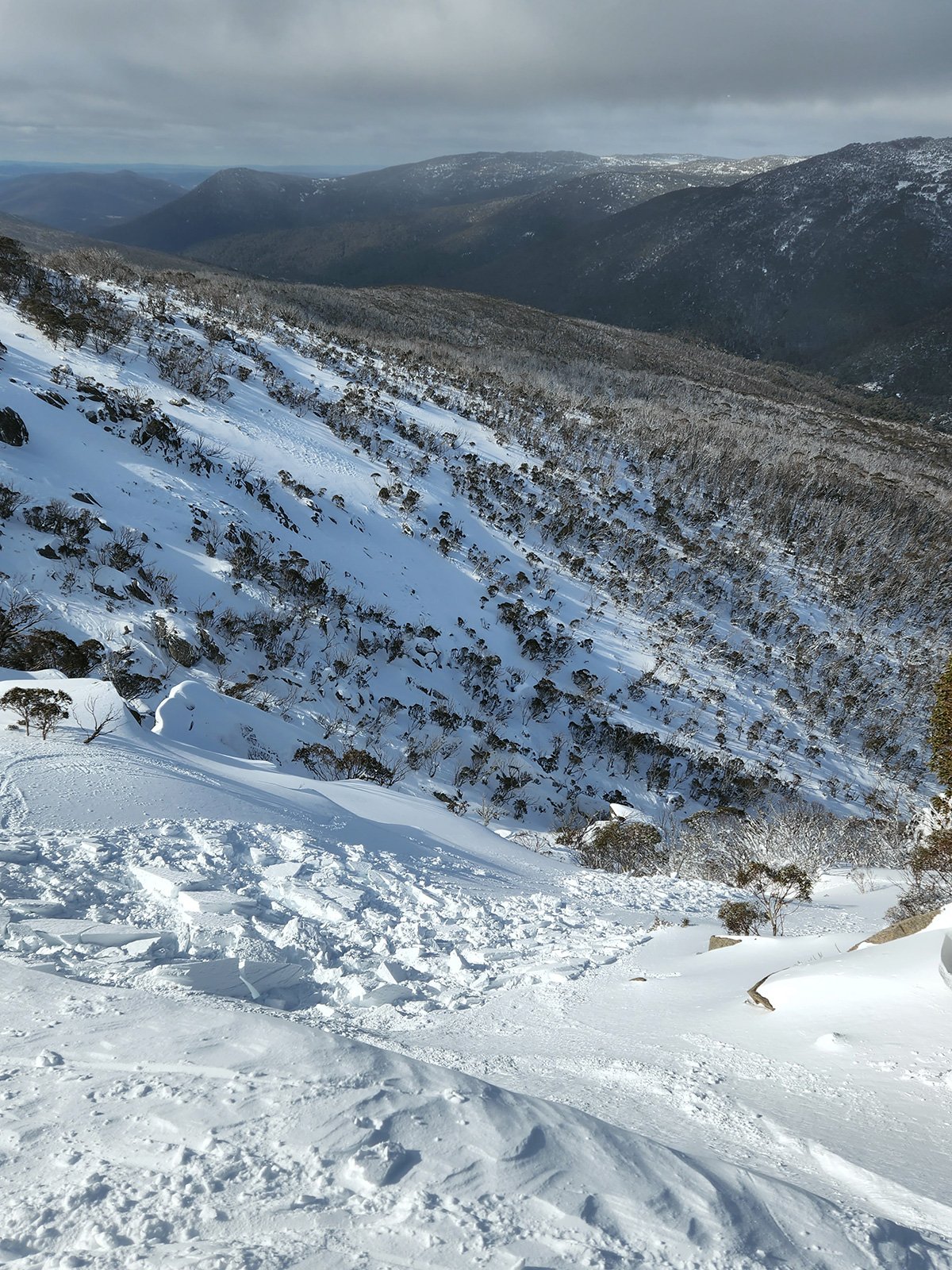It’s not often you hear a backcountry enthusiast hoping for more rain (be careful what you wish for!), but this has been the case through July as we gingerly avoided an ongoing wind slab problem in the alpine. These conditions have been relatively unusual for Australia in terms of the number and frequency of avalanches and the conditions that caused them.
While this article isn’t a technical analysis like MSC published about the Sentinel Ridge Slides in late June, it will highlight some of the issues we need to be aware of when venturing into the backcountry and how having a sense of what has been happening in the snowpack over the season can be critical to maintaining safe route planning.
Early season - lots of snow, and then some rain
The snowfall the mountains received in early June sat there for a few weeks without any substantial new snow. During this time, that early snowpack received some rain (possibly a contributing factor to the Sentinel Ridge wet-loose avalanches), refroze and created a hard, icy base for any subsequent snow to fall on.
A developing slab problem
In mid-July we saw a series of small tops-ups of snow. Each top-up was relatively small, but the moderate and strong winds picked up that snow from a wide area (called the ‘fetch’) and deposited it into wind drifts on the lee. In our mountains, the prevailing west winds typically transport snow onto east-facing slopes. In this case we saw dry snow accumulating to depths well over 50cm in places with many cornices growing to a couple of metres. This type of wind loading can be tricky to predict because it tends to be quite specific to the terrain and wind and snow in a particular spot. Having a wide array of field observations from different elevations, aspects and terrain features becomes critical to keep tabs on the problem.
An avalanche cycle
From July 16 onwards we started seeing skier triggered avalanches occurring in and out of the resorts. For example, an ice climber at Blue Lake triggered a wind slab and was pushed over a cliff - no injuries reported. Another slab avalanche inside a resort had a crown 2m high, 50m wide and ran for 100m, triggered by a controlled cornice collapse. Skiers also triggered an avalanche just outside of a resort boundary - again, no injuries reported, but a good reminder that easily accessible “sidecountry” is uncontrolled avalanche terrain. While these avalanches don’t seem like they might bury you, they can wash you off a cliff or into a deep gully. Why were these avalanches all happening? Because the new windloaded snow was not bonding well to the hard, icy, bed surface from the season’s initial snowpack, and sliding on that layer. We were now dealing with a persistent slab problem.
A skier-triggered windslab avalanche on 18 July 2022 just outside a resort boundary. Photo: David Kuhn
The problem was then exacerbated by the winds changing to a moist easterly airflow on July 19 as the low pressure system moved offshore. The accompanying mist and wind created a frozen crust on the snow surface that locked the drier windblown snow underneath it. So we now had crust on top of deeper dry snow on top of that original hard ice - all the ingredients for avalanche events, that turned out to be quite unusual for Australia.
A bluebird day on Wednesday July 20 revealed the extent of this problem, with a Size 3 avalanche (big enough to destroy a timber house as per the Canadian avalanche scale) naturally releasing on Twin Humps in Leather Barrel Creek. A backcountry guide inspected this avalanche up close in following days and reported the crown wall was at least 2m high in some places.
Twin Humps avalanche 19 July 2022. Photo: Alex Parsons
On the same day, ski tourers around Mount Townsend reported multiple, very loud whumpfs on flatter areas. This occurs when the crust collapses on the softer snow below, suddenly releasing the air underneath and is a rarely reported occurrence in Australia. Whumpfing can be a sign that an avalanche has the potential to propagate along that weak layer, and can result in the remote triggering of avalanches on steeper slopes above.
Victoria reported their own large avalanche just outside a resort boundary during the same period. As the images below illustrate, this avalanche propagated deeply across the weak layer in a wide gully and created a large debris field. This should give pause to anyone that doesn't think they need to carry avalanche safety gear in the “sidecountry”, but there were luckily no injuries associated with this event either.
The crown of the avalanche. Photo: Bill Barker
The debris field showing the volume of snow released by the avalanche. Photo: Bill Barker
With nothing to heal this weak bond beneath the wind slab, the MSC hazard forecast remained at Moderate in the alpine from that point on. While the slab became harder to trigger in snowpack tests as the days wore on, there were still concerning results (i.e. sudden collapses and smooth releases on the layer below). It was still possible to trigger an avalanche and the consequence was large (a size 2 -3 avalanche) enough to maintain a high degree of caution.
Can a weak bond low down in the snowpack heal?
Where does this hope for rain fit in? On Tuesday July 26, a band of pre-frontal precipitation swept over the mountains, bringing ~17mm of rain before it got colder and started snowing. This type of event is initially concerning, as it creates more weight in the upper snowpack with the potential to trigger an avalanche on the weak layer below. However, if the rain can penetrate to the weak layer, it may start promoting better bonding as it refreezes.
In this case, Victoria saw more rain in the following days, which did appear to penetrate to the weak layer and break it down enough to lower (but not eliminate) the risk of slab avalanche on that weak layer. In NSW, the initial rain appeared to only penetrate about 20cm into the snowpack, leaving the weak layer in place deep below.
At this point MSC changed the avalanche rating in Victoria to Low - while the slab may still have triggered, it was unlikely, and the size of the resulting avalanche was expected to be small because that weak layer was less robust and widespread. In NSW however, the avalanche rating continued at Moderate - the slab could still release in the right conditions, such as a skier load or a cornice collapsing on it. The size of the resulting avalanche was expected to be larger because the weak layer was more widespread and intact.
The layer these avalanches were sliding on is called a Persistent Weak Layer (PWL). PWLs can last throughout the winter, and mean that an avalanche on that layer can always be in the back of your mind. If you were in Canada in Winter 2021-2022, you might recall they had a widespread PWL from December that remained in place until the Spring thaw in May. These types of layers are unusual in Australia as the combination of our warm temperatures, low (but wet) snowfall and frequent rain events often break them down through the season.
A test pit showing 60cm of wind loaded snow on top of multiple melt freeze crusts with the compression test column that easily released on the right hand side.
New snow further burying the PWL
In the last week of July, NSW saw another few centimetres of snow accompanied by moderate winds. We now had a new wind slab problem that was 40-80cm deep on steep easterly slopes in the alpine. It was sitting on top of the older slab, on top of the PWL. With this new wind slab being so reactive (multiple human triggered events were reported), there was a risk that any new avalanche even only in the new slab might “step down” and trigger a deeper, larger avalanche running on that PWL below. The rating is currently set at Considerable to reflect the higher likelihood and consequence of a human-triggered avalanche. This is similar to what likely occurred in the large avalanche on Etheridge a few years ago.
More rain!
In the case of “Be careful what you wish for”, a significant rain event is upon us in the first week of August. While it’ll weaken and load be dangerous for the snowpack in the initial days, perhaps the rain will penetrate deep enough to start breaking down the PWL. We’ll just have to wait and see!
This is where MSC’s daily Backcountry Conditions Reports become crucial in terms of monitoring conditions for planning your backcountry tours. If we have more observations, the more accurate our reports will be, so please submit your own field observations or tag @mountain_safety_collective in any photos you post on Instagram of avalanches or other signs of instability you see out in the field.
Authors: Owen Lansbury & Alex Sinickas





